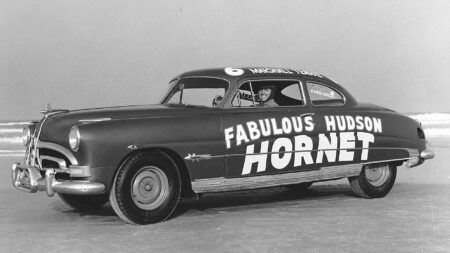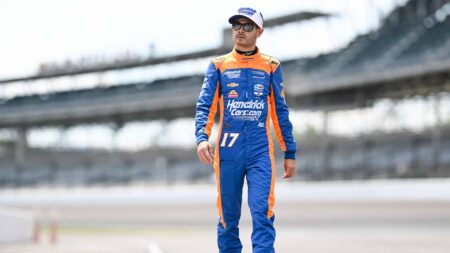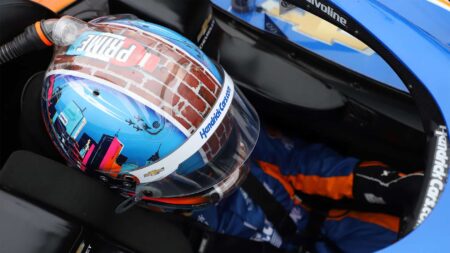
The real-life Hudson Hornet: story of a NASCAR icon
The massively successful Cars Disney film made Doc Hudson popular with fans young and old – James Elson tells the story behind the Hudson Hornet NASCAR it was based on
Mexico’s recent return to the world championship was a huge success, and that came as a surprise only to those who had never attended a race there in the old days. The country has always been passionate about motor racing in general, and Formula 1 in particular, and in the old days – up to 1993 – the race invariably pulled a massive crowd.
Perhaps there is a message here for Bernie Ecclestone and the wretched CVC Capital Partners: put on a grand prix in a country where the locals actually love racing, and what you get is a happening, an event to persuade you that maybe this sport is not, in the words of Dan Gurney, “becoming obsolete” after all.

![]()
If the race in Mexico City was a raging success, however, it necessarily had a negative effect on the US Grand Prix in Austin. Since the Circuit of the Americas – without doubt the best ‘new’ track of recent years – first hosted an F1 race in 2012, the crowds had been extremely healthy, boosted by a large contingent of Mexican fans, for whom this was the only grand prix within relatively easy reach.
This year, now with their own race a week after Austin, most opted not to make the trip to Texas, and this, combined with truly appalling weather, made for a very much smaller crowd. Throw in the fact that state subsidies for COTA have now been withdrawn, and the future is looking bleak for this latest incarnation of Formula 1 in America.
The presence of a local driver – someone to cheer for – makes a big difference to the appeal of a grand prix, and if Mexico may these days lack a star on the level of Pedro Rodríguez, still the spectators screamed themselves hoarse for Sergio Pérez.
As for the USA, back in the days when F1 seemed to have a genuine foothold there, fans had such as Dan Gurney and Phil Hill to cheer for, and for the next generation there was the magnetic pull of Mario Andretti, after Hill the only other American ever to become world champion.

![]()
Since then few drivers from across the pond have competed in F1, and none with any success. Rookie Alexander Rossi may have been on the grid in Austin this year, but with the best will in the world that was never going to have any great effect at the turnstiles.
Back in 1981 Rick Mears was invited to test for Brabham, first at Paul Ricard, where he was fractionally slower than Nelson Piquet, then later at Riverside, where he was quicker than the team’s resident world champion. Offered a drive, Mears ultimately decided to stick with Penske and Indycars, and to this day Herbie Blash, who was present at the test, talks of him as ‘the great lost world champion’.
From the archive: Jeff Gordon and Jimmie Johnson’s unique relationship (2012)
Who knows what a difference it might have made to the popularity of F1 in America if a star of Mears’s magnitude had taken over the mantle of Andretti, and competed in the world championship against the Prosts and Laudas and Sennas?
And there’s another name, too – that of a man who retired from motor racing last weekend, after finishing sixth in his final race at Homestead. At the age of 44, four-time champion Jeff Gordon leaves NASCAR with 93 victories – a tally beaten only by Richard Petty and David Pearson – to his name.

Gordon’s career has been largely spent in stock cars, but that wasn’t how he started. Born in California, based in Indiana, his prodigious ability was first apparent in sprint car racing, where he started winning at the age of 15. At 20 he won the USAC Silver Crown Championship, and at that stage his sights were set on a life in Indycars. It was only when nothing seemed to be on offer that he turned his attention to NASCAR, and this was surely a huge trick missed by American open-wheel racing.
Perhaps by Formula 1, too. In June 2003, prior to the Canadian Grand Prix, I went to Indianapolis for a couple of days, and was thus present for Tradin’ Places, an appealingly quirky publicity event, in which on the road course Gordon sampled Juan Pablo Montoya’s Williams-BMW, and JPM Jeff’s Chevrolet Monte Carlo.
The two drivers hit it off immediately, and apart from anything else there was considerable fun to be had from briefing each other on their respective cars. “You brake when?!” Gordon exclaimed at Montoya’s suggested stopping point for the first turn, and Juan Pablo was similarly nonplussed by Jeff’s advice: “You’re not serious – I mean, that’s halfway down the straight…”
It didn’t surprise me that Montoya lost no time in getting up to decent speed in the Chevy, but who knew what to expect of Gordon in the Williams, running with ‘full fat’ 3-litre V10 BMW power? This, believe it or not, was the very first rear-engined racing car he had ever driven. “Juan says not to worry if I spin – this thing has anti-stall, for God’s sake! Never heard of that in my life…”

Jeff left the pits cautiously, ran a slow first lap, a quicker second – and then looked like a Formula 1 driver. There was one brief off-track moment as he explored the car’s braking limits, but otherwise no mistakes, and as I watched him screaming round I could barely believe it.
He did, as far as I remember, about 15 laps, his best about half a second from Montoya’s time, and afterwards was in rapture about the experience. “I can’t even describe how the car felt,” he said. “The first time I put the brakes on, the blood rushed out of my head! The biggest thing is that, because you can drive in so deep because of the braking power, the corner comes up so fast, and, man, you’d better be prepared…
“In my car on a road course, I’m used to, you know, brake… wait a little bit… downshift… downshift… OK, now it’s time to turn… But the Williams is just point and shoot!”
Williams personnel were amazed not only by how swiftly Gordon came to terms with the car, but also by his pure pace, and Montoya, too, was more than slightly impressed. “I said Jeff would get within a couple of seconds of me, and he did way better than that. It’s a shame he didn’t get more time in the car – I’m sure he’d be as competitive as anyone in F1…”
Sadly, it was all too little too late. In 2003 Gordon was already 32, and a king in his own domain, but a NASCAR journalist friend told me that it was a very long time before Jeff ceased raving about his brief run in the Williams. “When he talked about it, he was kind of wistful – like this was what he should have done with his life.

“It’s the old story, though, isn’t it? What if? Everyone’s wise after the event. Jeff made his name in midgets and sprints – he isn’t a Southern boy, and his roots are in open-wheel racing. He tried hard to get a test with various Indy Lights teams, but unless he could bring a few dollars, they didn’t want to know. What a chance everyone missed…”
Undeniably so. It always seemed to me that Gordon was the most naturally gifted American driver of his generation, and could have turned his talents to anything. What struck me that June day, as he chatted easily with Montoya, was that, unlike most NASCAR stars, he even looked and sounded like an F1 driver. And in a handful of laps in the Williams, he looked like a man born to it.

The massively successful Cars Disney film made Doc Hudson popular with fans young and old – James Elson tells the story behind the Hudson Hornet NASCAR it was based on

NASCAR star Kyle Larson is attempting 'The Double' this Sunday, driving the Indianapolis 500 and Coca-Cola 600 on the same day – but several factors could stand in his way

'The Double' is a challenge like no other in motor sport – we look at the brave racers who've taken on the Indianapolis 500 and Coca-Cola 600 on the same day

NASCAR has aimed big with its new Drive to Survive Netflix imitator Full Speed: can the docudrama match its lofty ambitions?